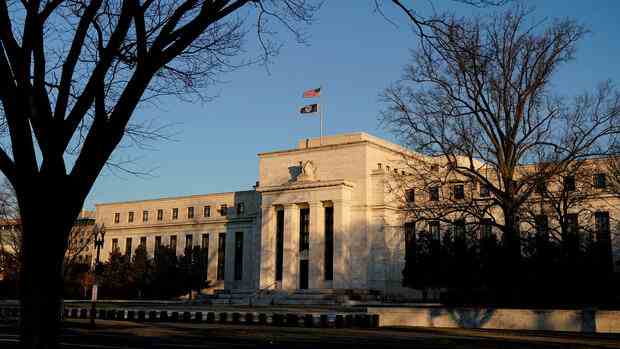Analysts had expected the US Federal Reserve to hike interest rates more slowly.
(Photo: Reuters)
Washington The US Federal Reserve (Fed) has initiated a new phase in monetary policy. It raised interest rates by 0.5 percentage points on Wednesday, slower than in previous months. The key interest rate is now in the range of 4.25 to 4.5 percent, as the Fed announced in Washington on Wednesday.
The central bankers led by Fed Chair Jerome Powell had previously raised interest rates by 0.75 percentage points four times in a row – the fastest rate in over 40 years. Overall, the central bankers are now assuming that the key interest rate will be higher in the coming year than initially assumed, even if the rate hikes are now smaller.
On average, monetary politicians assume that they will raise the key interest rate to up to 5.1 percent in 2023 before lowering it to 4.1 percent in 2024. This emerges from the economic forecasts of the central bankers, which were also published on Wednesday.
Stock market prices fall, Nasdaq loses the most
The Fed emphasized that it “takes into account the cumulative effects and time lags” with which monetary policy affects the US economy. Nevertheless, it initially put a damper on the stock markets.
Top jobs of the day
Find the best jobs now and
be notified by email.
The forecasts are “disappointing for the markets,” said David Kelley, chief strategist at JP Morgan Chase Asset Management. The broad S&P 500 fell 0.6 percent immediately after the interest rate decision. The tech-heavy Nasdaq was down 0.9 percent. The leading index Dow Jones lost 0.4 percent. Investors are apparently worried that the Fed’s policies could trigger a recession in the US, Kelley said.
The rapid and large interest rate increases this year are already being felt in several parts of the US economy. Tuesday’s data suggest inflation may have peaked. The inflation rate was 7.1 percent in November, down from 7.7 percent a month earlier. This means that inflation in the USA has fallen for the fifth time in a row.
Powell faces a difficult balancing act. The debate over the question of how far interest rates should rise will now come to a head. Diane Swonk, chief economist at KPMG
The housing market is in crisis mode in view of the high interest rates: Because loans have become unaffordable for many, the demand for residential property has collapsed. The job market, meanwhile, is surprisingly resilient.
According to economists, this new phase of smaller interest rate hikes is more difficult than the first significant interest rate hikes. Finally, the risk of sliding the economy into recession is now increasing, which could affect the Fed’s future course.
“Powell faces a difficult balancing act. The debate over the question of how far interest rates should rise will now come to a head. Linked to this is the question of when the key interest rate should fall again,” says Diane Swonk, chief economist at the auditor KPMG. Tuesday’s good inflation data is “very welcome, but until inflation doesn’t fall significantly further, it’s too early to be really happy.”
Star investor Jeffrey Gundlach of Double Line Capital expects a recession in the first half of 2023. Then the Fed would “turn around and cut interest rates again,” he said at an online event on Monday. The concern that the monetary politicians could cause great damage to the economy is greater than the will to fight inflation. “Even if the central bankers are currently saying something else.”
